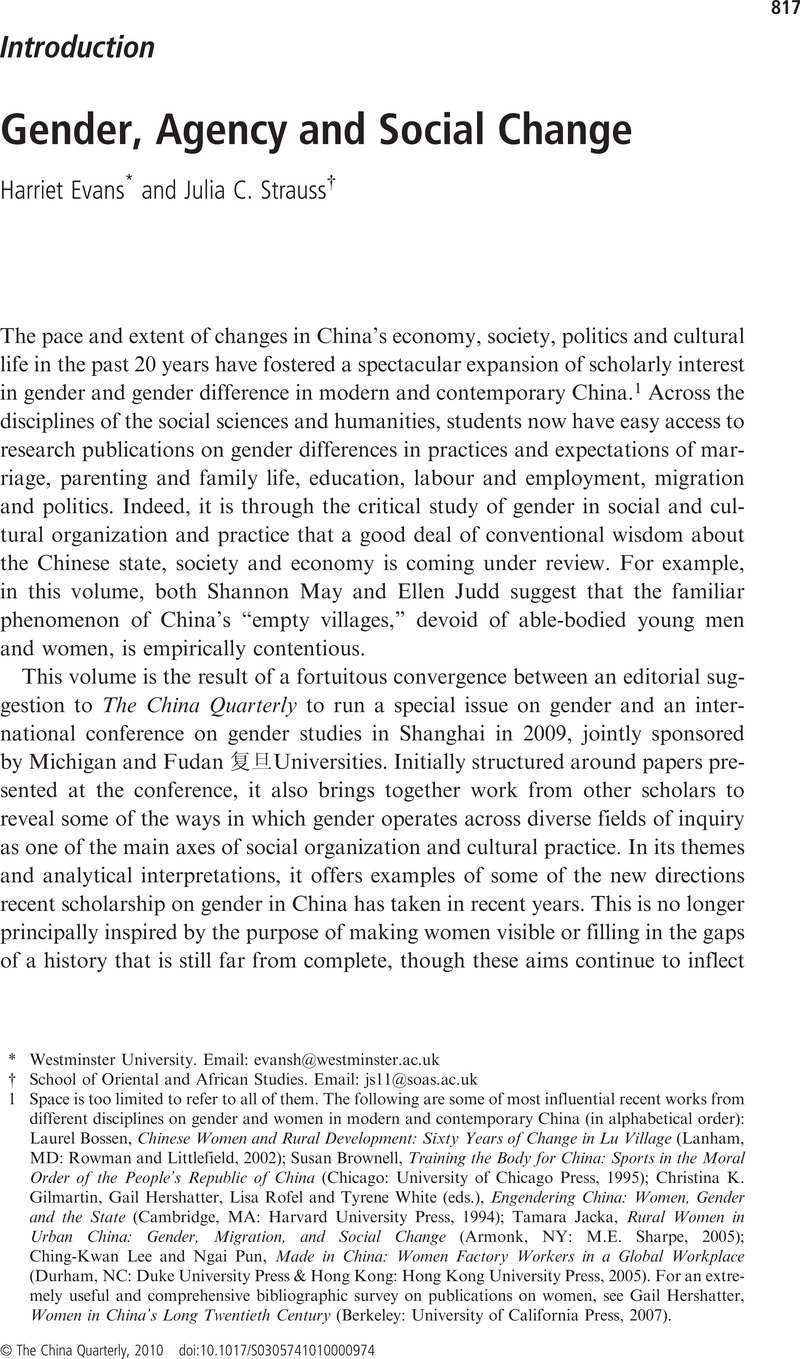Article contents
Gender, Agency and Social Change
Published online by Cambridge University Press: 07 December 2010
Abstract

- Type
- Introduction
- Information
- Copyright
- Copyright © The China Quarterly 2010
References
1 Space is too limited to refer to all of them. The following are some of most influential recent works from different disciplines on gender and women in modern and contemporary China (in alphabetical order): Bossen, Laurel, Chinese Women and Rural Development: Sixty Years of Change in Lu Village (Lanham, MD: Rowman and Littlefield, 2002);Google ScholarBrownell, Susan, Training the Body for China: Sports in the Moral Order of the People's Republic of China (Chicago: University of Chicago Press, 1995);Google ScholarGilmartin, Christina K., Hershatter, Gail, Rofel, Lisa and White, Tyrene (eds.), Engendering China: Women, Gender and the State (Cambridge, MA: Harvard University Press, 1994);Google ScholarJacka, Tamara, Rural Women in Urban China: Gender, Migration, and Social Change (Armonk, NY: M.E. Sharpe, 2005);Google ScholarLee, Ching-Kwan and Pun, Ngai, Made in China: Women Factory Workers in a Global Workplace (Durham, NC: Duke University Press & Hong Kong: Hong Kong University Press, 2005).Google Scholar For an extremely useful and comprehensive bibliographic survey on publications on women, see Hershatter, Gail, Women in China's Long Twentieth Century (Berkeley: University of California Press, 2007).CrossRefGoogle Scholar
2 Glosser, Susan, “‘The truths I have learned’: nationalism, family reform and male identity in China's new culture movement, 1915–1923,” in Brownell, Susan and Wassertrom, Jeffrey N. (eds.), Chinese Femininities/Chinese Masculinities: a Reader (Berkeley: University of California Press, 2002), pp. 120–44.CrossRefGoogle Scholar
3 Yunxiang, Yan, The Individualization of Chinese Society (Oxford: Berg Publishers, 2010).Google Scholar
4 Lihong, Shi, ‘Little quilted vests to warm parents’ hearts, The China Quarterly, No. 198 (2009), pp. 348–63Google Scholar, makes exactly this point with respect to her fieldsite in a north China village.
5 Bray, Francesca, Technology and Gender: Fabrics of Power in Late Imperial China (Berkeley: University of California Press, 1997)Google Scholar; Ebrey, Patricia Buckley, The Inner Quarters: Marriage and the Lives of Chinese Women in the Sung Period (Berkeley: University of California Press, 1993)Google Scholar; Furth, Charlotte, A Flourishing Yin: Gender in China's Medical History, 960–1665 (Berkeley: University of California Press, 1999)Google Scholar; Ko, Dorothy, Teachers of the Inner Chambers: Women and Culture in Seventeenth-Century China (Stanford, CA: Stanford University Press, 1994)Google Scholar; Mann, Susan, The Talented Women of the Zhang Family (Berkeley: University of California Press, 2007).Google Scholar
6 Freedman, Maurice, Lineage Organization in Southeastern China (London: Athlone Press, 1958).Google Scholar
7 Cohen, Myron, House United, House Divided: The Chinese Family in Taiwan (New York: University of Columbia Press, 1976).Google Scholar
8 Margery Wolf argued long ago that in their status as mothers, particularly of sons, women were able to exercise considerable authority in decisions concerning, for example, the allocation of family property. A woman's status as creator of her “uterine family” gave her an agency often overlooked in emphases on the patrilineal and patriarchal structure of the family. Wolf, Margery, Women and the Family in Rural Taiwan (Stanford, CA: University of California Press, 1972).Google Scholar
9 Discussion about masculinity in China has been more prominent in the humanities than the social sciences. See Louie's, KamTheorising Chinese Masculinity: Society and Gender in China (Cambridge: Cambridge University Press, 2002)Google Scholar, and Geng's, SongThe Fragile Scholar: Power and Masculinity in Chinese Culture (Hong Kong: Hong Kong University Press, 2004).Google ScholarHird, Derek combines ethnographic research with the analysis of media texts and images in “The sexual ambiguities of white-collar masculinity,” Sexuality Research in China, Vol. 30, No. 3 (2009), pp. 107–20Google Scholar, and “Models of masculinity? White collar images at work in contemporary China,” in Hemelryk, Donald S., Schilbach, T. and Cucco, I. (eds.), Other Stories/Missing Histories: Reflections from the Jiu Year in China (Hong Kong: Hong Kong University Press, forthcoming, 2010)Google Scholar. Brownell and Wasserstrom's Chinese Femininities/Chinese Masculinities remains unique as a volume examining the gendered constitutions of men's as well as women's lives across different times and fields of enquiry.
10 Zhong Xueping, “Hou funü jiefang yu ziwo xiangxiang” (“Post-women's liberation and self reflexivity”), Dushu (November 2005), pp. 13–20.
11 Hershatter, Women in China's Long Twentieth Century, pp. 111–18.
- 3
- Cited by




